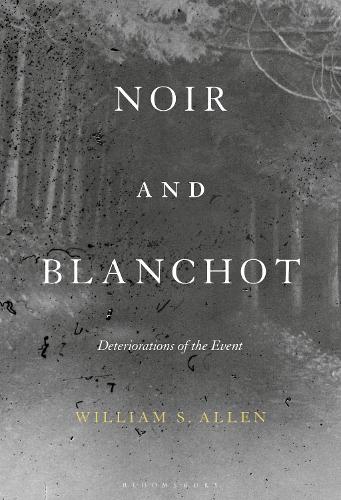
Noir and Blanchot: Deteriorations of the Event
(Paperback)
Publishing Details
Noir and Blanchot: Deteriorations of the Event
By (Author) Dr William S. Allen
Bloomsbury Publishing PLC
Bloomsbury Academic USA
29th July 2021
United States
Classifications
Professional and Scholarly
Non Fiction
Film: styles and genres
Western philosophy from c 1800
791.43655
Physical Properties
Paperback
200
Width 152mm, Height 229mm
268g
Description
In dark or desperate times, the artwork is placed in a difficult position. Optimism seems nave, while pessimism is no better. During some of the most demanding years of the 20th century two distinctive bodies of work sought to respond to this problem: the writings of Maurice Blanchot and American film noir. Both were seeking not only to respond to the times but also to critically reflect them, but both were often criticised for their own darkness. Understanding how this darkness became the means of responding to the darkness of the times is the focus of Noir and Blanchot, which examines key films from the period (including Double Indemnity and Vertigo) alongside Blanchots writings (particularly his 1948 narrative Death Sentence). What emerges from this investigation is the complex manner in which these works disrupt the experience of time and the event and in doing so expose an entirely different mode of material expression.
Reviews
It is tempting to respond to dark times with the light of optimism. But as William S. Allen shows in Noir and Blanchot, this is to fall into the trap of darkness. In a pathbreaking exploration of using darkness to forge a way out of darkness, Allen brings together two unlikely allies - film noir and Maurice Blanchot - to disrupt the prevailing dark times. * Todd McGowan, Professor of English, University of Vermont, USA *
Georges Bataille had compared Maurice Blanchot with the main character of Invisible Man, but nobody had dared pairing the elusive writer with film noir. Noir and Blanchot accomplishes this daring hermeneutic feat: it makes sense to read Death Sentence wedged between Double Indemnity and Vertigo. Not only are all three underpinned by Hegelian negation of negation, but also the Gothic features of Blanchot's narratives stand out. Thanks to Allen's brilliant insight, Blanchot appears less as a French Kafka than as a literary Bla Tarr. * Jean-Michel Rabat, Professor of English and Comparative Literature at the University of Pennsylvania, USA, and member of the American Academy of Arts and Sciences *
William S. Allen once again shows himself to be an expert guide through the complexities of Blanchot's thought. In limpid and elegant prose, Noir and Blanchot engages an expansive range of references whose common element is the darkness of an age - an age that is still ours - in which existence goes on in the disaster of extreme alienation. Allens prismatic readings of Blanchot show us as never before how to enter thinking into that darkness. * Jeff Fort, Associate Professor of French, University of California, Davis, USA, and author of The Imperative to Write: Destitutions of the Sublime in Kafka, Blanchot, and Beckett (2014) *
Author Bio
William S. Allen is an independent researcher at the University of Southampton, UK. He is the author of Ellipsis: Of Poetry and the Experience of Language after Heidegger, Hlderlin, and Blanchot (2007), Aesthetics of Negativity: Blanchot, Adorno, and Autonomy (2016), Without End: Sades Critique of Reason (Bloomsbury, 2018), and Blanchot and the Outside of Literature (Bloomsbury, 2019).
